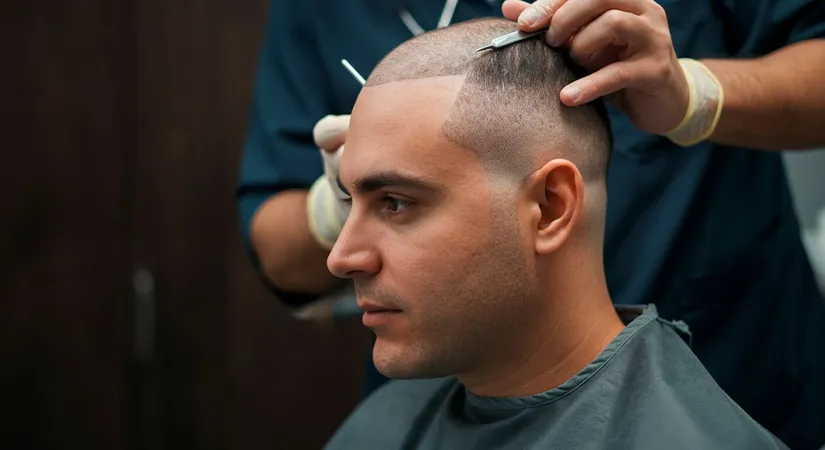Unlock Your Confidence: The Ultimate Guide to Hair Transplantation
Unlock the secret to restoring your hair and confidence with our comprehensive guide on hair transplantation.
Welcome to your ultimate guide on unlocking confidence through hair transplantation. Hair loss can be a distressing experience, affecting self-esteem. Fortunately, hair transplantation offers a solution to reclaim your hair and confidence. In this guide, we'll explore everything from understanding the procedure to choosing the best clinics and techniques. Whether you're considering follicular unit extraction or curious about scalp micropigmentation, we've got you covered with comprehensive insights and cost considerations.
Understanding Hair Transplantation: What You Need to Know
Types of Hair Transplantation Techniques
Hair transplantation techniques have evolved significantly, offering various methods to suit different needs. The two primary techniques are Follicular Unit Transplantation (FUT) and Follicular Unit Extraction (FUE). Each method has its unique approach and benefits.
Benefits of Hair Transplantation
Hair transplantation offers numerous benefits, including natural-looking results and permanent hair growth. It is a viable solution for those experiencing hair loss due to genetics or medical conditions.
Common Questions About Hair Transplantation
Many people have questions about hair transplantation, such as its permanence and how it works. Understanding these aspects can help individuals make informed decisions about undergoing the procedure.
Key Benefits of Hair Transplantation
- Natural appearance: Transplanted hair blends seamlessly with existing hair.
- Permanent solution: Once transplanted, hair continues to grow naturally.
- Boosts confidence: Restores hair and enhances self-esteem.
Steps in Hair Transplant Surgery
- Consultation: Discuss goals and evaluate hair loss pattern.
- Preparation: Donor area is prepared, and follicles are extracted.
- Transplantation: Follicles are implanted into the balding area.

Choosing the Best Hair Transplantation Clinics for Optimal Results
Key Factors to Consider When Selecting a Clinic
Choosing the right clinic for hair transplantation is essential for achieving optimal results. The expertise of the medical team is a critical factor. Look for clinics with experienced surgeons who specialize in hair restoration techniques.
Advanced technology is another important consideration. Clinics that utilize the latest equipment and methods, such as robotic-assisted follicular unit extraction, often provide better outcomes. This technology enhances precision and reduces recovery time.
Patient reviews offer valuable insights into a clinic's reputation. Positive feedback from previous patients can indicate a clinic's reliability and success rate. It's beneficial to read reviews on multiple platforms to get a comprehensive view.
Evaluating Clinic Credentials and Facilities
Accreditation and certifications are indicators of a clinic's credibility. Ensure the clinic is certified by relevant health authorities and professional organizations. This ensures adherence to high standards of care and safety.
Visit the clinic to assess its facilities. A well-maintained and hygienic environment reflects the clinic's commitment to patient care. Modern amenities and comfortable settings can enhance the overall experience.
Checklist for Choosing a Hair Transplant Clinic
- Verify the surgeon's credentials and experience in hair transplant surgery.
- Check for the use of advanced technology like robotic-assisted FUE.
- Read patient reviews across various platforms for unbiased opinions.
Steps to Ensure a Successful Clinic Selection
- Research and shortlist clinics based on expertise and technology.
- Schedule consultations to discuss your needs and evaluate the clinic's approach.
- Make an informed decision based on credentials, facilities, and patient feedback.

Exploring Hair Restoration Techniques: From Follicular Unit Extraction to Scalp Micropigmentation
Comparing Follicular Unit Extraction and Scalp Micropigmentation
Follicular Unit Extraction (FUE) and Scalp Micropigmentation (SMP) are two prominent hair restoration techniques, each catering to different needs. FUE involves extracting individual hair follicles from a donor site and implanting them into thinning areas. This method is ideal for those seeking natural hair growth.
In contrast, Scalp Micropigmentation is a non-surgical technique that uses micro-needles to deposit pigment into the scalp, creating the illusion of fuller hair. SMP is suitable for individuals who prefer a shaved look or want to enhance the appearance of hair density without surgery.
Ideal Candidates for Each Technique
FUE is best suited for individuals with sufficient donor hair and those looking for a permanent solution to hair loss. It is particularly beneficial for those who wish to restore hair in specific areas, such as the hairline or crown.
On the other hand, SMP is ideal for people experiencing diffuse thinning or complete baldness. It offers a quick solution with minimal downtime, making it appealing to those who want immediate results without undergoing surgery.
Key Differences Between FUE and SMP
- FUE involves surgical extraction and implantation of hair follicles, while SMP uses pigment to simulate hair.
- FUE results in natural hair growth, whereas SMP provides a visual enhancement of hair density.
- FUE requires a recovery period, while SMP offers immediate results with minimal downtime.
Steps in the FUE Process
- Consultation: Assess hair loss and determine donor site suitability.
- Extraction: Individual follicles are carefully removed from the donor area.
- Implantation: Follicles are strategically placed in thinning or balding areas.
Cost and Considerations: How Much Does Hair Transplantation Really Cost?
Factors Influencing Hair Transplantation Costs
The cost of hair transplantation is influenced by several factors, including the complexity of the procedure and the expertise of the surgeon. Each individual's hair loss pattern and desired outcome can significantly impact the overall expense.
Geographical location also plays a crucial role in determining costs. Clinics in metropolitan areas may charge more due to higher operational expenses. Additionally, the type of technique used, such as Follicular Unit Extraction (FUE) or Scalp Micropigmentation (SMP), can affect pricing.
Post-procedure maintenance is another consideration. Patients may need follow-up treatments or products to ensure optimal results, adding to the overall cost. Understanding these factors helps individuals plan financially for their hair restoration journey.
Key Considerations for Hair Transplantation
- Procedure complexity: More extensive hair loss may require more grafts and time.
- Surgeon's expertise: Highly experienced surgeons may charge premium rates.
- Technique choice: Different methods have varying costs and recovery times.
- Consultation: Initial assessment to determine the best approach and estimate costs.
- Procedure: Execution of the chosen technique tailored to the patient's needs.
- Follow-up: Post-surgery care and potential additional treatments for maintenance.
Innovative Hair Restoration Techniques: FUE and SMP
Ensuring Excellence in Hair Transplantation Processes
Frequently Asked Questions
What is hair transplantation and how does it work?
How much does hair transplantation cost?
What are the differences between Follicular Unit Extraction and Scalp Micropigmentation?
Is hair transplantation a permanent solution?
What should I consider when choosing a hair transplantation clinic?
Discover the path to 'Healthy Beauty' with estethica's expert care. Call now for your free consultation and take the first step towards a more confident you!
📞 Call for Your Free Consultation